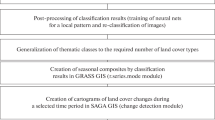Abstract
The complex structure of the lands of dry steppe Trans-Volga is represented by both natural steppe areas and fallow lands (areas of irrigated and rainfed agriculture), as well as pastures. This is often the reason for the distortion of the results of assessing the land state when using a methodology of land-degradation neutrality (LDN). The concept of LDN was proposed by the United Nations Convention to Combat Desertification (UNCCD) as an international standard to conduct comparative assessments and to analyze the dynamics of land degradation. The work considers the peculiarities of differences in the results obtained using low- and high-resolution space images. Using a ground verification of changes in the soil cover, validation of the proposed method for assessing the land-cover dynamics at the local level is carried out. The method is based on the analysis of seasonal series of Landsat images using self-organizing neural networks realized in a Scanex Image Processor program complex.







Similar content being viewed by others
REFERENCES
Dobrovol’skii, G.V., Fedorov, K.N., Stasyuk, N.V., et al., Standardization of the plain Dagestan soil cover and its anthropogenic stability, Pochvovedenie, 1991, no. 3, pp. 5–13.
Karibaeva, K.N. and Kurochkina, L.Ya., Smeny rastitel’nosti i ikh regulirovanie pri pastbishchnom ispol’zovanii (Taukumy) (Plant Succession and Its Control under Rangeland Utilization (Taukumy)), Alma-Ata, 1991.
Achieving Land Degradation Neutrality at the Country Level. Building blocks for LDN Target Setting, Global Mechanism of the UNCCD, 2016. http://www2.unccd.int/sites/default/files/documents/18102016_LDN% 20country%20level_ENG.pdf. Cited June 2, 2022.
Mozharova, N.V. and Fedorov, K.N., Evolution of soil mesostructures from accumulative-marine plane of Tersko-Kumskaya lowland, Biol. Nauki, 1990, no. 2, pp. 15–20.
Kust, G.S., Andreeva, O.V., and Lobkovskii, V.A., Neural balance of land degradation is a modern approach for national researching arid regions, Aridnye Ekosist., 2020, vol. 26, no. 2 (83), pp. 3–9.
Belyaeva, M.V., Andreeva, O.V., Kust, G.S., and Lobkovskii, V.A., Estimation experience for land degradation dynamic at the southern part of European Russia by using neural balance of land degradation, Ekosist.: Ekol. Din., 2020, vol. 4, no. 3, pp. 145–165.
Programma obrabotki dannykh distantsionnogo zondirovaniya ScanExImageProcessor v 5.1. Modul’ tematicheskoi interpretatsii (Tematik Pro). Rukovodstvo pol’zovatelya (ScanExImageProcessor v 5.1 Software for Distant Probe Data Processing. Thematic Interpretation Module (Tematik Pro). User’s Manual), Moscow, 2019.
Smagin, A.V., Teoriya i praktika konstruirovaniya pochv (Soil Constructing: Theory and Practice), Moscow, 2012.
Huang, D., Wang, K., and Wu, W.L., Dynamics of soil physical and chemical properties and vegetation succession characteristics during grassland desertification under sheep grazing in an agropastoral transition zone in Northern China, J. Arid Environ., 2007, vol. 70, no. 1, pp. 120–136.
Quinn, J.W., Band Combination. http://web.pdx.edu/~emch/ip1/bandcombinations.htm. Cited June 2, 2019.
Key, C. and Benson, N., Landscape assessment: remote sensing of severity, the normalized burn ratio; and ground measure of severity, the composite burn index, in FIREMON: Fire Effects Monitoring and Inventory System, RMRS-GTR, Ogden, UT: USDA Forest Service, Rocky Mountain Research Station, 2005.
Land Cover CCI. Product User Guide. Version 2.0. http://maps.elie.ucl.ac.be/CCI/viewer/download/ESACCI-LC-Ph2-PUGv2_2.0.pdf. Cited June 2, 2022.
Orr, B.J., Cowie, A.L., Castillo, V.M.S., et al., Scientific Conceptual Framework for Land Degradation Neutrality. A Report of the Science-Policy Interface, Bonn: United Nations Convention to Combat Desertification (UNCCD), 2017. https://www.unccd.int/resources/publications/scientific-conceptual-framework-land-degradation-neutrality-report-science. Cited June 2, 2022.
Trends.Earth Documentation. Release 1.0.4, 30.06.2021. https://trends.earth/docs/en/pdfs/Trends.Earth.pdf. Cited June 2, 2022.
Funding
This study was carried out within the framework of an order of a state order to the Institute of Geography, Russian Academy of Sciences, FMWS-2022-0001 “Spatial and Temporal Issues of Sustainable Land Use in the Context of Global Climate Change.”
Author information
Authors and Affiliations
Corresponding authors
Ethics declarations
COMPLIANCE WITH ETHICAL STANDARDS
This article does not contain any studies involving animals and human participants performed by any of the authors.
CONFLICT OF INTEREST
The authors declare that they have no conflict of interest.
Additional information
Translated by A. Barkhash
About this article
Cite this article
Slavko, V.D., Andreeva, O.V. & Kust, G.S. Peculiarities of Assessment of Land-Cover Dynamics at the Local Level Using Space Images (on the Test Area of the Dry Steppe Trans-Volga). Moscow Univ. Soil Sci. Bull. 77, 333–342 (2022). https://doi.org/10.3103/S014768742205009X
Received:
Revised:
Accepted:
Published:
Issue Date:
DOI: https://doi.org/10.3103/S014768742205009X




